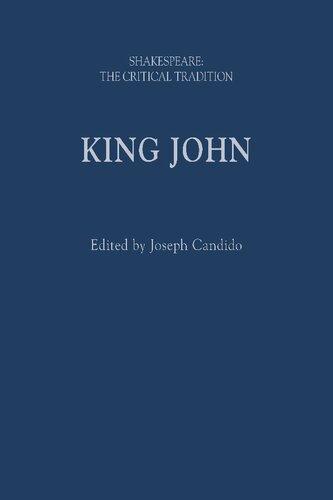Formyparents
Acknowledgments
Thereisasmall,butgrowinginterestinunderstandingtheFourthGospelin lightofearlyJudaism.Bythisstatement,Idonotmean “earlyJudaismas background” totheGospelnordoImean “JohnandJudaism,” butrather ImeanreadingtheFourthGospelaspartofearlyJudaism.Thisperspective turnsmuchtwentieth-centuryJohanninescholarshiponitshead,butitisthe twentieth-centurydiscoveryoftheDeadSeaScrollsthathasbeentheimpetus behindourenrichedunderstandingsofJudaismduringtheSecondTemple period.ReadingtheGospelofJohnalongsideearlierandcontemporaryJewish literatureopensnew(orrenewed?)avenuesforunderstandingtheFourth Gospel,particularlyinrelationshiptoJewishapocalyptictradition.
Thepresentstudygrewoutofthecolloquiumonthe “GospelofJohnand IntimationsofApocalyptic” hostedbyCatrinWilliamsin2010atthe UniversityofWales,BangorinhonorofJohnAshton.Mypaper “John amongtheJewishApocalypses:RethinkingtheGospelofJohn’sGenre” was dyingaslow,painfuldeathinthequestionandanswerperioduntilJohn Ashtonshiftedtheconversationbyrespondingfavorablywhilealsograciously challengingme.John’sinteractionsparkedmyinterestinthetopicfurtherand beganafriendshipwhichcontinueduntilhisdeath.JohnandIcommunicated backandforthasheworkedonwhatbecamehis finalbook, TheGospelofJohn andChristianOrigins (Fortress,2014),andasIcontinuedworkingonthe GospelofJohn’srelationshipwithJewishapocalypses. Johnagreedtowritea forewordforthepresentvolume,butItooktoolongtocompletethisproject andheleftustoosoon.However,IimagineJohn’scommentswouldhave soundedsimilartohisresponsetosomeofmyearlierwork: “itwon’tsurprise youtohearthatIagreewithmuchofwhatyousay.Butitwon’tsurpriseyou eithertohearthatIdohavesomedisagreementsalso,andIthinkIoweitto youtospelltheseout.” IamgratefultoJohnforhisforthrighthonesty,his encouragement,hiscontributiontoJohanninescholarship,andhisfriendship. TherearenumerouspeoplewhomIwouldliketothankfortheiradviceand encouragementonthepresentvolume.IamgratefultoJohnAshtonandJörg Freyforofferingfeedbackonmypreliminaryoutlineforthisproject.Iwould alsoliketothankthosewhoreadachapterormoreofthepresentvolumeand inmanyinstanceschallengedmetorethinkanargumentorsavedmefrom
someembarrassingoversights.Theseincludecolleagues:IanBoxall,Joseph Dodson,NatashaDuquette,SimonGathercole,JonathanMoo,StaceyMoo, IanScott,andCatrinWilliams;andsomeformerandcurrentstudents: MorganClark,SpencerHealey,BenKlassen,andRachelVanderVeen.Of course,thosemistakesthatremainareminealone.Iamalsogratefulto RachelVanderVeenforcompilingtheListofAbbreviationsandtoMarina Hannaforrecreatingthetableof “master-paradigm” elements.
IwouldalsoliketothankallthosewhowerepresentattheBangor Colloquiumin2010,particularlyJohnAshton,IanBoxall,AprilDeConick, JörgFrey,JuttaLeonhardt-Balzer,JudithLieu,ChristopherRowland,Loren Stuckenbruck,andCatrinWilliams,fortheintellectuallystimulatingmeeting thatitwas.Iamgratefultootherswhohaveheardandcommentedonpaper presentationsthathavebeenincorporatedintothisvolume,whichIgavein theinterveningyearsattheSixthEnochSeminar(Milan,June2011);the JohannineLiteratureSection,SBLAnnualMeeting(Chicago,2012);Wisdom andApocalypticismSectionandJohannineLiteratureSectionjointsession, SBLAnnualMeeting(SanDiego,2014).
Iamgratefultothepublishers Bloomsbury,Brill,FortressPress,and MohrSiebeck forpermittingmetoreusematerialfrompreviouslypublished essays.Inmostcases,Ihavesignificantlyreworkedthematerial,butinafew instances,thedetailedargumentmaybefoundintheoriginalpiece:
“JohnandtheJewishApocalypses:RethinkingtheGospelofJohn’sGenre.” In John’sGospelandIntimationsofApocalyptic,editedbyCatrinH.Williamsand ChristopherRowland,36–57.London:BloomsburyT&TClark,animprintof BloomsburyPublishingPlc.,2013.(IncorporatedintoportionsofChapters2 and5.)
“ApocalypticismintheGospelofJohn’sWrittenRevelationofHeavenly Things.” EarlyChristianity 4,no.1(2013):64–95,publishedbyMohr Siebeck,Tübingen.(IncorporatedintoportionsofChapters2,3,and6.)
“TheOtherworldlyMediatorsin4Ezraand2Baruch:AComparisonwith AngelicMediatorsinAscentApocalypsesandinDaniel,Ezekiel,and Zechariah.” In FourthEzraandSecondBaruch:ReconstructionaftertheFall, editedbyMatthiasHenzeandGabrieleBoccaccini,175–93.Leiden:Brill,2013. (IncorporatedintoportionsofChapters2and5.)
“ApocalypticRevelationintheGospelofJohn:RevealedCosmology,the VisionofGod,andVisionaryShowing.” In JewishApocalypticTraditionand theShapingofNewTestamentThought,editedbyBenjaminE.Reynoldsand
LorenT.Stuckenbruck,109–28.Minneapolis,MN:FortressPress,2017. (IncorporatedintoportionsofChapters2and3.)
Iamalsogratefulforthepermissionsgrantedtoincludeimagesoficons depictingSt.JohntheTheologiandictatingtohisscribeProchorusthatare includedonthecoverofthisvolumeandinChapter7.
IamgratefultoTyndaleUniversityfortwohalf-yearsabbaticals(winter 2015andautumn2018)duringwhichamajorityofthisbookwasresearched andwritten.Withoutthefreedomfromadministrativeandteachingloads duringthosetwosemesters,Iwouldnothavebeenabletocompletethis project.ThankstothestaffofTyndaleUniversity’sWilliamHorseyLibrary fortheirresearchandteachingsupport,especiallytoHughRendle,Isabella Guthrie-McNaughton,andMonicaDuce.
ThankstotheSisterhoodofSt.JohntheDivine,particularlytoJeanette Strong,SisterDorothy,andSisterSusanneattheGuestHouseandSister MargaretRuthinthelibrary,forthepeacefulstudyspaceforresearchand writingandtheirkindhospitality.TheSisterhoodwillalwaysholdaspecial placeforme,butitdoessoespeciallywiththisprojectbecause,asmythoughts werecoalescingaroundtheGospelofJohn,Jewishapocalypses,andthebook ofRevelation,Inoticedforthe firsttimeanicon(aquitelargewallpainting, mindyou)thatIhadpassednumeroustimesbefore.TheSisterhood’sicon sparkedareceptionhistoryexplorationoftheliteraryandiconographic traditionofSt.John,Prochorus,andtheCaveofRevelation,andthisexplorationledtothecentralpartofChapter7ofthisvolume.
Iwouldalsoliketothanktheanonymousreviewersfortheirhelpful feedback,aswellasTomPerridge,KarenRaith,JohnSmallman,Henry Clarke,andtherestoftheOUPteamfortheirpatienceandexcellentwork onthisvolume.
Last,butnotleast,IwouldliketothankLizzieandourthreeboysfortheir encouragementandpatience,especiallyinthe finalstagesoftheproject(“Dad, didyou finishyourbooktoday?”).IdedicatethisbooktomyparentsMelissa andRogerReynoldsoutofgratitudefortheirunwaveringloveandsupport.
ListofIllustrations xiii
ListofAbbreviations xv Introduction1
1.Genre, “Apocalypse,” andtheGospelofJohn15
2.TheMannerofRevelationinJewishApocalypsesandJohn37
3.TheContentofRevelationinJewishApocalypsesandJohn67
4.TheFunctionofRevelationinJewishApocalypsesandJohn93
5.John’sGospelas “Apocalyptic” Gospel117
6.Interpretingthe “Apocalyptic” GospelwithJewishApocalypses144
7.The “Apocalyptic” GospelandtheApocalypseofJohn167 Conclusion201 AppendixA:TheJewishApocalypses211 AppendixB:TheJewishApocalypsesandtheGospelofJohn212
ListofAbbreviations
ABAnchorBible
ABDAnchorBibleDictionary,6vols.,ed.DavidNoelFreedman,NewYork, 1992
ABRLAnchorBibleReferenceLibrary
AGJUArbeitenzurGeschichtedesAntikenJudentumsunddesUrchristentums
AJECAncientJudaismandEarlyChristianity
AnBibAnalectaBiblica
ANFAnte-NiceneFathers
ATRAustralasianTheologicalReview
BBETBeiträgezurbiblischenExegeseundTheologie
BBRBulletinforBiblicalResearch
BETLBibliothecaephemeridumtheologicarumlovaniensium
BibBiblica
BISBiblicalInterpretationSeries
BJSBrownJudaicStudies
BMSECBaylor-MohrSiebeckStudiesinEarlyChristianity
BNTCBlack’sNewTestamentCommentaries
BZNWBeiheftezurZeitschriftfürdieneutestamentlicheWissenschaft
CBETContributionstoBiblicalExegesisandTheology
CBQCatholicBiblicalQuarterly
CBQMSCatholicBiblicalQuarterlyMonographSeries
CBSCoreBiblicalStudies
CCConcordiaCommentary
CCRCambridgeCompanionstoReligion
CCSSCatholicCommentaryonSacredScripture
CEJLCommentariesonEarlyJewishLiterature
CRINTCompendiaRerumIudaicarumadNovumTestamentum
CurBRCurrentsinBiblicalResearch
DCLSDeuterocanonicalandCognateLiteratureStudies
DCLYDeuterocanonicalandCognateLiteratureYearbook
DOPDumbartonOaksPapers
DOSDumbartonOaksStudies
ECCEerdmansCriticalCommentary
EJLEarlyJudaismanditsLiterature
ExpTExpositoryTimes
HbibStHerdersBiblischeStudien/Herder’sBiblicalStudies
HBTHorizonsinBiblicalTheology
HNTHandbuchzumNeuenTestament
HTRHarvardTheologicalReview
HTSHarvardTheologicalStudies
ICCInternationalCriticalCommentary
IDBSupInterpreter’sDictionaryoftheBible:SupplementaryVolume,ed. K.Crim.Nashville,1976
IRTIssuesinReligionandTheology
ITCInternationalTheologicalCommentary
ITQIrishTheologicalQuarterly
JAJSupJournalofAncientJudaismSupplements
JBLJournalofBiblicalLiterature
JCTJewishandChristianTexts
JSJJournalfortheStudyofJudaisminthePersian,Hellenistic,andRoman Periods
JSJSupJournalfortheStudyofJudaism,SupplementSeries
JSNTJournalfortheStudyoftheNewTestament
JSNTSupJournalfortheStudyoftheNewTestamentSupplementSeries
JSPSupJournalfortheStudyofthePseudepigraphaSupplementSeries
JTSJournalofTheologicalStudies
KDKerygmaundDogma
LBSLinguisticBiblicalStudies
LECLibraryofEarlyChristianity
LNTSLibraryofNewTestamentStudies
MNTSMcMasterNewTestamentStudies
MSmanuscript
NHMSNagHammadiandManichaeanStudies
NIGTCNewInternationalGreekTestamentCommentary
NovTNovumTestamentum
NovTSupNovumTestamentum,Supplements
NTLNewTestamentLibrary
NTOANovumTestamentumetOrbisAntiquus
NTRNewTestamentReadings
NTSNewTestamentStudies
NTTNewTestamentTheology
OEDOxfordEnglishDictionary
OTPTheOldTestamentPseudepigrapha. 2vols.,ed.JamesH.Charlesworth, NewYork:Doubleday,1983,1985
OTRMOxfordTheologyandReligionMonographs
PMLAProceedingsoftheModernLanguageAssociation
RBLReviewofBiblicalLiterature
RBSResourcesforBiblicalStudies
RechBibRecherchesBibliques
RNTRegensburgerNeuesTestament
RSBReligiousStudiesBulletin
RSRRecherchesdesciencereligieuse
SAAAStudiesontheApocryphalActsoftheApostles
SANtStudiaAarhusianaNeotestamentica
SBLDSSocietyofBiblicalLiteratureDissertationSeries
SBLMSSocietyofBiblicalLiteratureMonographSeries
SBLRBSSocietyofBiblicalLiteratureResourcesforBiblicalStudy
SBLSBSSocietyofBiblicalLiteratureSourcesforBiblicalStudy
SBTStudiesinBiblicalTheology
SCSSeptuagintandCognateStudies
SEÅSvenskexegetiskårsbok
SJsStudiaJudaeoslavica
SNTSSocietyforNewTestamentStudies
SNTSMSSocietyforNewTestamentStudiesMonographSeries
STDJStudiesontheTextsoftheDesertofJudah
SVTPStudiainVeterisTestamentipseudepigraphica
TBNThemesinBiblicalNarrative
THKNTTheologischerHandkommentarzumNeuenTestament
TJTrinityJournal
TSAJTexteundStudienzumantikenJudentum
TZTheologischeZeitschrift
WBCWordBiblicalCommentary
WUNTWissenschaftlicheUntersuchungenzumNeuenTestament
ZNWZeitschriftfürdieneutestamentlicheWissenschaftunddieKundeder älterenKirche
Introduction
Withoutdoubt,theGospelofJohnhasaplaceamongthefourGospelsasa narrativetellingofthelifeofJesus,¹butfromthebeginningofthefourfold Gospel,theGospelaccordingtoJohnhasbeenunderstoodtoberecognizably different,astheeaglesoaringaboveMatthew,Mark,andLuke.Althoughthe GospelofLukeandthelongerendingofMarkrecountJesus’sascensionto heaven(Luke24:51;Mark16:19),JohnframesJesus’slifebypresentinghimas onewhowaswiththeGod “inthebeginning” andwhois “fromabove.” John speaksofJesus’sdescentfromheaven,hisbeingsentbytheFather,andhis returntotheFather.JohnalsoportraysJesusasspeakingtheFather’swords, doingtheFather’sworks,andbeingonewiththeFather.
TherearemanymoredifferencesbetweentheSynopticGospelsandJohn, butthequestionsthatcontinuetopuzzleinterpretersarewhyJohnisdifferent andhowwecanexplainJohn’sdistinctivenessamongtheGospels.Asis oftennoted,ClementofAlexandriareferredtoJohnasa “spiritualgospel” (πνευματικὸν εὐαγγέλιον),incontrastto “thebodily” content(τὰ σωματικὰ) in “theGospels” (Eusebius, Hist.eccl.6.14.7).WhilewhatClementmeantby thatdescriptionisnotentirelyclear,hiscommentisoneoftheearliest acknowledgmentsofJohn’sdifferencefrom,andyetsimilarityto,Matthew, Mark,andLuke.
John’sdistinctivenesshasearneditvariousdescriptorsfromitsmanyinterpreters,suchas “themaverickGospel,”²a “dramatischeErzählung,”³and “the propheticGospel.”⁴ Inaddition,JohnhasbeencomparedwithGnosticism,⁵
¹D.MoodySmith, JohnamongtheGospels,2ndedn(Columbia,SC,2001);andevenamongthe “other” gospels,onwhich,seeLorneR.Zelyck, JohnamongtheOtherGospels:TheReceptionofthe FourthGospelintheExtra-CanonicalGospels,WUNT,II/347(Tübingen,2013).
²RobertKysar, John,theMaverickGospel,3rdedn(Louisville,KY,2007).
³MichaelTheobald, DasEvangeliumnachJohannes.Kapitel1–12,RNT(Regensburg,2009),14–17.
⁴ AnthonyTyrrellHanson, ThePropheticGospel:AStudyofJohnandtheOldTestament,Scholars’ EditionsinBiblicalStudies(London,2006).
⁵ RudolfBultmann, “DieBedeutungderneuerschlossenenmandäischenundmanichäischen QuellenfürdasVerständnisdesJohannesevangeliums,” ZNW,24(1925),100–46.
JohnamongtheApocalypses:JewishApocalypticTraditionandthe “Apocalyptic” Gospel.BenjaminE.Reynolds, OxfordUniversityPress(2020).©BenjaminE.Reynolds. DOI:10.1093/oso/9780198784241.001.0001
mysticism,⁶ drama,⁷ rhetoric,⁸ wisdom,⁹ Greco-Romannovels,¹⁰ thetrial motif,¹¹narrativephilosophy,¹²andthelistgoeson.Manycomparisonshave alsobeenmadetovarioustypesofliteratureandliterarytechniques,¹³includingarecentcomparisonofJohnwithNorthropFrye’sarchetypes.¹⁴ Inaddition,Jo-AnnBrant,GeorgeParsenios,andKasperBroLarsenhavehighlighted variousliterarytechniquesevidentinJohn,fromdramaticdialoguetofarewell andrecognitionscenes.¹⁵ Thelistofcomparisonscontinuesbecause,asHarold Attridgememorablyargues,Johnappearstobendgenre.¹⁶ Withregardto genretheory,thebending,or “skewing,” asRuthSheridanreferstoit,¹⁷ of genremightbeconsideredgenericchange(i.e.,changerelatedtogenre)orthe modificationorextensionofgenre.Modificationofgenrecommonlyoccurs whenauthorscreateanewtextwithintheboundariesofexistinggenre expectationsbutextendthegenrebyplayingwiththosesameexpectations.¹⁸
Whiletheremaybevariousgenre “type-scenes” intheGospelofJohn,itis notablethattheseembeddedgenres(partialgenressetwithinalargergenre)do notfunctionacrosstheentiretyoftheGospel.Forexample,embeddedgenres
⁶ JeyJ.Kanagaraj, “Mysticism” intheGospelofJohn:AnInquiryintoitsBackground,JSNTSup,158 (Sheffield,1998);AprilD.DeConick, VoicesoftheMystics:EarlyChristianDiscourseintheGospelsof JohnandThomasandOtherAncientChristianLiterature,JSNTSup,157(Sheffield,2001).
⁷ Jo-AnnA.Brant, DialogueandDrama:ElementsofGreekTragedyintheFourthGospel (Peabody, MA,2004);alsoBenWitherington,III, John’sWisdom:ACommentaryontheFourthGospel (Louisville,KY,1995),4–5.
⁸ MargaretDavies, RhetoricandReferenceintheFourthGospel,JSNTSup,69(Sheffield,1992).
⁹ MartinScott, SophiaandtheJohannineJesus,JSNTSup,71(Sheffield,1992);WilliamR.G.Loader, JesusinJohn’sGospel:StructureandIssuesinJohannineChristology (GrandRapids,MI,2017).
¹
⁰ MeredithJ.C.Warren, MyFleshIsMeatIndeed:ANonsacramentalReadingofJohn6:51–8 (Minneapolis,MN,2015);Jo-AnnA.Brant, “JohnamongtheAncientNovels,” in TheGospelofJohnas GenreMosaic,ed.byKasperBroLarsen,SANt,3(Göttingen,2015),157–68.
¹¹AndrewT.Lincoln, TruthonTrial:TheLawsuitMotifintheFourthGospel (Peabody,MA,2000).
¹²TroelsEngberg-Pedersen, JohnandPhilosophy:ANewReadingoftheFourthGospel (Oxford, 2017).
¹³MarkW.G.Stibbe, JohnasStoryteller:NarrativeCriticismandtheFourthGospel,SNTSMS,73 (Cambridge,1992).
¹
⁴ BrianLarsen, ArchetypesandtheFourthGospel:LiteratureandTheologyinConversation,T&T ClarkBiblicalStudies(London,2018).
¹
⁵ Jo-AnnA.Brant, John,Paideia(GrandRapids,MI,2011);GeorgeL.Parsenios, Departureand Consolation:TheJohannineFarewellDiscoursesinLightofGreco-RomanLiterature,NovTSup,117 (Leiden,2005);KasperBroLarsen, RecognizingtheStranger:RecognitionScenesintheGospelofJohn, BIS,93(Leiden,2008);GeorgeL.Parsenios, RhetoricandDramaintheJohannineLawsuitMotif, WUNT,I/258(Tübingen,2010).
¹
⁶ HaroldW.Attridge, “GenreBendingintheFourthGospel,” JBL,121/1(2002),3–21;Harold W.Attridge, “TheGospelofJohn:GenreMatters?,” in TheGospelofJohnasGenreMosaic,ed.by KasperBroLarsen,SANt,3(Göttingen,2015),27–45;HaroldW.Attridge, “Genre,” in HowJohnWorks: StorytellingintheFourthGospel,ed.byDouglasEstesandRuthSheridan(Atlanta,GA,2016),7–22.
¹
⁷ RuthSheridan, “John’sGospelandModernGenreTheory:TheFarewellDiscourse(John13 17) asaTestCase,” ITQ,75/3(2010),287–99.
¹
⁸ AlastairFowler, KindsofLiterature:AnIntroductiontotheTheoryofGenresandModes (Cambridge,MA,1982),23–4;HetaPyrhönen, “Genre,” in TheCambridgeCompaniontoNarrative, ed.byDavidHerman(Cambridge,2007),118–19.
inJohnmayincludea “farewellscene” inJohn13–17ora “betrothalscene” in John4,butneither,Iwouldargue,saysmuchaboutJohn3or10or20. Throughoutthisstudy,myconcernwillbewhetherornotwemaydetermine agenericmodethatexplainstheGospelofJohn’ s “genrebending.” Aswillbe discussedmorefullyinChapter1,modesprovidea “thematicandtonal qualification” toagenre,¹⁹ suchasa “comicnovel” ora “romanticcomedy.”²⁰
SpeakingofJohnasa “genremosaic” helpfullyhighlightstheexistenceof various embeddedgenres presentintheGospel,²¹butIcontendthatpaying attentiontothegenericmodeoftheGospelofJohnoffersusabetterwayto explaintheframingofJohn’sGospelasarevelatorynarrativeanditsdistinctivenessfromtheSynopticGospels.²²
CallingJohna “propheticGospel”²³ordescribingitasbeingshapedbythe HebrewBible²⁴ approachesthemodalunderstandingoftheGospelinits entiretyandrecognizestheunderlyingdebtandoverwhelminginfluenceof theScripturesofIsraelonJohn’snarrativeofJesus.²⁵ Attridge’sargumentfor Johnas “dramatic” alsotendstowardamodaldescription,butthefour “dramatic” featuresheoffersasevidencearenotconsistentacrossthe Gospel,particularlythe “delayedexit” and “recognitionscene” whichare foundinonlyafewpassages.²⁶ AdeleReinhartz’sdescriptionofJohnasa “cosmologicaltale” comesmuchcloser,inmyopinion,todescribingthe Gospel’soverarchingheavenlyandrevelatoryperspectiveonJesus’slife.²⁷ TheframingoftheGospelfromtheperspectiveofJesus’sdescentfrom heaven,hisbeingsentfromthepresenceoftheFather,hisspeakingthe wordsoftheFather,hisdoingtheFather’sworks,hismakingtheFather
¹⁹ JohnFrow, Genre,TheNewCriticalIdiom,2ndedn(London,2015),73.
²⁰ Fowler, KindsofLiterature,106–8;Frow, Genre,69–74.Seethesection “GenreTheory” in Chapter1.
²¹SeeKasperBroLarsen,ed., TheGospelofJohnasGenreMosaic,SANt,3(Göttingen,2015).
²²SeeAttridge, “GenreMatters?,” 32–4;Sheridan, “John’sGospel,” 298–9.
²³Hanson, ThePropheticGospel
²⁴ SaeedHamid-Khani, RevelationandConcealmentofChrist:TheologicalInquiryintotheElusive LanguageoftheFourthGospel,WUNT,II/120(Tübingen,2000).
²⁵ SeeAliciaD.MyersandBruceG.Schuchard,eds., AbidingWords:TheUseofScriptureinthe GospelofJohn,SBLRBS,81(Atlanta,GA,2015);CraigS.Keener, TheGospelofJohn:ACommentary,2 vols(GrandRapids,MI,2003),47–51.
²⁶ Attridge, “GenreMatters?,” 34–40.
²
⁷ AdeleReinhartz, TheWordintheWorld:TheCosmologicalTaleintheFourthGospel,SBLMS,45 (Atlanta,GA,1992),16–28;relatedly,Loader, JesusinJohn’sGospel,423–55.Cf.Frey’spost-Easter perspectiveonJesusinJörgFrey, TheGloryoftheCrucifiedOne:ChristologyandTheologyintheGospel ofJohn,trans.byWayneCoppinsandChristophHeilig,BMSEC(Waco,TX,2018).WhileFrey’sview addressesthepost-Easterrecognitionofthedisciples(John2:22;12:16),suchaperspectiveisnot entirelydistinctamongthefourGospels(Luke24:25–7;24:44–6;seethefulfillmentpassagesinMatt. 1–2).
known,andhisreturningtotheFather²⁸ isthemostdistinctivedifference betweentheFourthGospelandMatthew,Mark,andLuke.
WhatisthebestwaytodescribeJohn’sothernessincomparisontothe SynopticGospels,itstendencytowardskewingandbendinggenre,andfrom wheremightthisheavenlyperspectivederive?Weseemto findourselvesback atRudolfBultmann’sriddlesaboutwhattheGospelofJohnreveals,thepoint fromwhichJohnAshton,TroelsEngberg-Pedersen,andWilliamLoaderhave alsobeguntheirstudiesoftheFourthGospel.²⁹ Bultmanncontendedthatthe twosignificantquestionsconcerningJohnare “WhatisJohn’splaceinthe developmentofearlyChristianity?” and “Whatisitscentralvision[zentrale Anschauung],itsbasicconcept[Grundkonzeption]?”³⁰ Hisanswertothe first question MandeanGnosticism hasallbutbeenabandonedinscholarship, particularlyinlightourgreaterawarenessofearlyJudaismfollowingthe discoveryofandscholarshipontheDeadSeaScrollsandtheresultingrenewal ofinterestinotherearlyJewishliterature.Withregardtohissecondquestion, BultmannwascorrecttoarguethatJohn’ s Grundkonzeption isrevelation (Offenbarung)asdisclosedbyJesustherevealerthroughhiswordsand deeds.³¹
WithinJohanninescholarship,revelationiscommonlyrecognizedasthe centralizingfeatureoftheGospelofJohn.Bultmann’sowncommentaryis structuredaroundtheconceptofrevelation,withhistwomajordivisionsof theGospelentitled “Chapters2–12:TheRevelationofthe ΔΌΞΑ tothe World” and “Chapters13–20:TheRevelationofthe ΔΌΞΑ beforethe Community.”³²He,ofcourse,famouslysaidthatJesusistheRevealerbut thatthereisnocontenttotherevelationapartfromrevealingthatheisthe Revealer.³³ManystudiesandcommentariesontheFourthGospel,whether theyexplicitlyfollowBultmann’sleadornot,arealsostructuredaroundthe
²⁸ ThesefeaturesarewhatWilliamLoaderconsidersthecentralstructureoftheGospel.SeeLoader, JesusinJohn’sGospel.
²
⁹ JohnAshton, UnderstandingtheFourthGospel,2ndedn(Oxford,2007),2–11;Engberg-Pedersen, JohnandPhilosophy,1–3;Loader, JesusinJohn’sGospel,2–12.
³⁰ Bultmann, “DieBedeutung,” 100,102.³¹SeeAshton, Understanding,491–529.
³²RudolfBultmann, TheGospelofJohn:ACommentary,trans.byG.R.Beasley-Murray,R.W.N.Hoare, andJ.K.Riches(Philadelphia,PA,1971),vii–xii.
³³Bultmann, “DieBedeutung,” 102;RudolfBultmann, TheologyoftheNewTestament,trans.by KendrickGrobel,2vols(NewYork,1951), ,66.Engberg-Pedersen, JohnandPhilosophy,2,notesthat WilliamWredemadethisexactpointtwentyyearsbeforeBultmann.
RevelationintheGospelofJohn
conceptofrevelation.Forexample,MichaelTheobalddividestheGospelinto “RevelationoftheSontotheWorld” and “RevelationoftheSontohisOwn.” PaulRainbow’schaptersinclude: “TheRevelationofGod(theFather),”“God’ s Self-RevelationinChrist’sPerson,”“God’sSelf-RevelationinChrist’sWork,” and “TheRevelationoftheFatherintheSonbytheParaclete.”³⁴ Within moderncriticalscholarship,however,Bultmannwasnotthe firsttohighlight revelationasacentralizingthemeoftheFourthGospel.BernhardWeiss commentsonJohanninerevelationinhis LehrbuchderbiblischenTheologie desNeuenTestaments,whichwasoriginallypublishedin1868.Weiss’sstatementssoundeerilyfamiliar: “Asthelivingorganoftherevelationofthe Father,JesusmustknowHimselfassuch,andthispresupposesthatHe perfectlyknowstheFather,whoisrevealedinHisworks.” Andagain: “the contentsofHiswordare,tobesure,withJohnmainlyHimselfagain, i.e. the meaningoftherevelationgiveninHispersonandHisworks.”³⁵ HugoHuber, acontemporaryofBultmann,alsoarguedthatJesusistheRevealerandthat Jesus’swordsandsignsarethemediumofthatrevelation.³⁶ Halfacentury later,GailO’DaynotesthecentralityofrevelationinJohnbutfocusesonthe revelatorynatureofthetext: “Itis...notthecontentofwhatJesussaysbutthe factthatanencounterwiththedivineoccursthatisatthecoreofrevelationin John.”³⁷ Inarecentcommentary,FrancisMartinandWilliamWright,IVhave madeasimilarclaim: “Jesus’ wholelife hisperson,words,anddeeds isa revelationoftheFather,ofhimselfastheSon,andoftheinfinitelovebetween them.”³⁸ PhilipvandenHeedecontinuesthetraditionarguingthatrevelation isacentralcategoryforJohnandthattheformofJesus’srevelationisatthe sametimeitscontent.³⁹ Thesescholarsarepartofalong-standingrecognition withinJohanninescholarshipthatrevelationiscentraltotheGospel.
³⁴ Theobald, Evangelium,27–8;PaulA.Rainbow, JohannineTheology:TheGospel,theEpistlesand theApocalypse (DownersGrove,IL,2014).
³⁵ BernhardWeiss, LehrbuchderbiblischenTheologiedesNeuenTestaments (Berlin,1868).Citations fromtheEnglishtranslationofWeiss’sthirdedition:BernhardWeiss, BiblicalTheologyoftheNew Testament,trans.byJamesE.Duguid,2vols(Edinburgh,1883), ,332,352.MyinteractionwithWeissis indebtedtoJamesM.Boice, WitnessandRevelationintheGospelofJohn (GrandRapids,MI,1970),45.
³⁶ HugoH.Huber, DerBegriffderOffenbarungimJohannes-Evangelium:einBeitragzum VerständnisderEigenartdesviertenEvangeliums (Göttingen,1934),27,84.However,thereisa troublingemphasisontheGospel’snewnessandoppositiontoJewishtheology(57).
³⁷ GailR.O’Day, RevelationintheFourthGospel:NarrativeModeandTheologicalClaim (Philadelphia,PA,1986),39.
³
⁸ FrancisMartinandWilliamM.Wright,IV, TheGospelofJohn,CCSS(GrandRapids,MI,2015),24.
³⁹ PhilippevandenHeede, DerExegetGottes.EineStudiezurjohanneischenOffenbarungstheologie, HBibSt,88(Freiburg,2017),13,25–6.SeealsoMichaelLabahn, OffenbarunginZeichenundWort: UntersuchungenzurVorgeschichtevonJoh6,1-25aundseinerRezeptioninderBrotrede,WUNT,II/117 (Tübingen,2000),283,forJesus’srevelationindeedandword.
Intriguingly,arguments for theexistenceandcentralityofrevelationinthe FourthGospelaretypicallynotforthcominginJohanninescholarship.The mostlikelyreasonforthisisthattherevelatorynatureoftheGospelappears quiteobvious.Jesus’smakingtheFatherknownseemsto fitageneralunderstandingof “revelation” (John1:18),nottomentionthatJesus reveals hisglory (ἐφανέρωσεντὴνδόξαναὐτοῦ,2:11).Inherepiloguetothevolume John’ s GospelandIntimationsofApocalyptic,AdelaYarbroCollinsquestions whetherBultmannwascorrectinhisassessmentofrevelationasthecentral outlookoftheGospelofJohn.Shestates, “Aclosereading[oftheGospelof John]revealsthatthethemesofrevelationandJesusasrevealerareless dominantthanRudolfBultmann,forexample,supposed.”⁴⁰ YarbroCollins viewsJesusnotsomuchasrevealerbutasdelegateforGodandasasalvific figure.ToputthisinmoreexplicitlyJohannineterms,John’sJesusismore Savioroftheworld(4:42)thanrevealersentfromheaven.⁴¹Shesays, “The redeemerdoesnotdescendandascendprimarilytoconveyrevelationbutto savetheworld.”⁴²ThisperspectivecomesoutmoreclearlyinYarbroCollins’ s readingoftheSonofMan’sdescentandascentinlightofthecrucifixion(3:13 with3:14⁴³).Likewise,theascentmentionedin6:62,sheclaims,isnotan ascentbut “equivalenttothe ‘liftingup’,thatis,thecrucifixion.”⁴⁴ Laura Holmes,inherreviewofthevolume,suggeststhatYarbroCollins’scritique concerningtherevelatorynatureofJohnundercutstheprojectofunderstandingthethemeofrevelationintheFourthGospelas “intimationsofapocalyptic.”⁴⁵ IdisagreewithHolmes’sassessmentthatYarbroCollinsundercutsthe projectbecausetherearedifferentunderstandingsof “apocalyptic” atplay
⁴⁰ AdelaYarbroCollins, “Epilogue,” in John’sGospelandIntimationsofApocalyptic,ed.byCatrin H.WilliamsandChristopherRowland(London,2013),307.
⁴¹YarbroCollins, “Epilogue,” 302–3,305. ⁴²YarbroCollins, “Epilogue,” 304.
⁴³Acorrespondencebetween ὑψόω andthecrucifixionmaybeargued,butG.C.Nicholson, Death asDeparture:TheJohannineDescent-AscentSchema,SBLDS,63(Chico,CA,1983),141,listsnofewer than fivemajorinterpretationsofthemeaningof ὑψόω intheGospelofJohn.Thecrucifixionis generallyunderstoodaspartofthemeaningof ὑψόω,butthequestioniswhetherthetermprimarily referstothecrucifixionasJesus’sexaltationorthecrucifixionasthebeginningofhisexaltation,which isthencompletedinJesus’sresurrectionandreturntotheFather.Inmyopinion,theinterpretationof John3:14;8:28;and12:34intermsof2:22;7:39;and12:16indicatesthatthe “liftingup”/exaltationof JesusincludesthecrucifixionbutisnotcompleteduntilhereturnstotheFather.SeeRaymond E.Brown, TheGospelaccordingtoJohn(I–XII):Introduction,Translation,andNotes,AB,29 (GardenCity,NY,1966),146.Foralongerdiscussion,seeBenjaminE.Reynolds, TheApocalyptic SonofManintheGospelofJohn,WUNT,II/249(Tübingen,2008),122–7.Frey, GloryoftheCrucified One,247–51,however,arguesfortheexaltationprimarilythroughcrucifixion.
⁴⁴ YarbroCollins, “Epilogue,” 303,apparentlymissestheword “before” in6:62.Shealsoconnects 1:51tothecrucifixion(301).
⁴⁵ LauraC.S.Holmes, “Reviewof John’sGospelandIntimationsofApocalyptic,EditedbyCatrin H.WilliamsandChristopherRowland,” RBL,2015,https://www.bookreviews.org/bookdetail.asp? TitleId=9697,accessedApril3,2020.
betweenthecontributorstothevolumeandYarbroCollins.⁴⁶ Nevertheless, YarbroCollinsandHolmeshelpfullychallengeJohanninescholarship’soften unsupported assumption thatrevelationistheFourthGospel’ s “zentrale Anschaaung,seineGrundkonzeption.”⁴⁷ Johanninescholarshaveprobably fortoolongassumedthecorrectnessofBultmann’sviewwithoutarguingfor it,eveniffewhavefoundhiscontentionofagnosticRedeemermythoriginfor thatrevelationviable.⁴⁸ YarbroCollins’sandHolmes’scritiqueshighlightthe needtodefine “revelation” andtoargueforitsimportanceintheFourthGospel.
Defining “Revelation”
“Revelation” isgenerallyunderstoodtorefertothemakingknownofsomethingthatwaspreviouslyunknown.Accordingtothe OxfordEnglish Dictionary, “revelation” canalsorefertomakingsomethingknownthatwas merelyunrecognized.Itmayalsorefertotheactorexperienceofsomething unknownbeingmadeknown(i.e., “arevelation”),⁴⁹ a “sourceofenlightenment,” oralsosomethingthatinspiresawe(“TheGospelofJohnisarevelation”).ThesortofrevelationthatisconsideredtobepresentintheFourth Gospelisthegenerallyunderstoodmeaning,namelythatsomethingunknown ismadeknown.However,theoriginofthatrevelationisalsoanimportant partofthedefinition.The OED definitionthatbestdefinestherevelation BultmannreferredtoandwhichIwilluseinthefollowingstudyis: “1.a.)The disclosureorcommunicationofknowledge,instructions,etc., bydivineor supernaturalmeans ”⁵⁰ YarbroCollinsis,Ithink,justifiedinpointingoutthat Johanninescholarstendtoassumethedominanceofthissortofrevelationin theGospelofJohn;however,Ithinksheisincorrecttosuggestthat “revelation” isnotcentraltotheGospelofJohn.Havingdefined “revelation” inthis way,IwillargueforthepresenceandcentralityofrevelationintheGospelin thefollowingsection.
⁴⁶ ItshouldbenotedthatYarbroCollinswasnotinattendanceattheBangorColloquiumandwrote theepilogueinresponsetothecompletedessays.
⁴⁷ Bultmann, “DieBedeutung,” 102.
⁴⁸ Ashton, Understanding,3,referstoBultmann’sMandeanhypothesisas “oneoftheoddestofthe manyremarkablebitsofjetsamthatlittertheshoresofJohanninescholarship.”
⁴⁹ BothBoice, WitnessandRevelation,andO’Day, RevelationintheFourthGospel,addressthe theologicalaspectsofnaturalandsupernaturalrevelationintheiropeningsections.
⁵⁰ OxfordEnglishDictionary (Oxford,2000),http://dictionary.oed.com/entrance.dtl,s.v. “revelation” (emphasismine).MarkusN.A.Bockmuehl, RevelationandMysteryinAncientJudaismand PaulineChristianity,WUNT,II/36(Tübingen,1990),2,definesrevelationsimilarly: “‘Revelation’ designatesa)anydivinedisclosurecommunicatedbyvisionaryorpropheticmeans,orb)themanifestationofheavenlyrealitiesinahistoricalcontext.”













